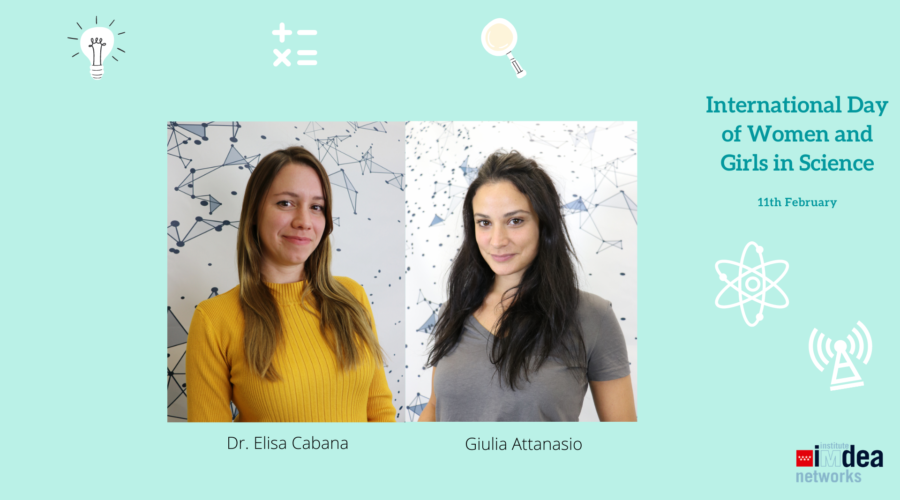IMDEA Networks

Elisa Cabana y Giulia Attanasio, dos jóvenes investigadoras que apostaron por carreras STEM
Ambas desarrollan su carrera profesional en IMDEA Networks Institute y son ejemplos de vocación científica
11 Febrero 2021

La escasa presencia de mujeres que estudian carreras STEM (ciencia, tecnología, ingeniería y matemáticas, por sus siglas en inglés) es una tendencia mundial. Precisamente, con el fin de lograr el acceso y la participación de las mujeres y niñas en la ciencia, cada 11 de febrero se celebra el Día Internacional de la Mujer y la Niña en la Ciencia, proclamado por la ONU en 2015.
Según los últimos datos publicados por la UNESCO, “menos del 30% de los investigadores del mundo son mujeres”. Esta disparidad es preocupante en tanto que la mayor parte de los empleos del futuro están vinculados a estas disciplinas. “La matrícula de estudiantes femeninas es particularmente baja en el campo de la tecnología de la información y las comunicaciones (TIC), con un 3%; ciencias naturales, matemáticas y estadísticas, con un 5%; y en ingeniería, manufactura y construcción, con un 8%”, tal y como recoge la UNESCO en su informe publicado en 2019.
En España, las cifras no distan mucho de las proporcionadas por los organismos internacionales. Según las estadísticas universitarias facilitadas por el Ministerio de Educación y Formación Profesional para el curso 2018-2019, solo el 12,9% de los matriculados en informática son mujeres y en el caso de ingenierías, construcción e industria la cifra se sitúa en el 28,5%.
Para Elisa Cabana (30 años), investigadora Postdoc en IMDEA Networks, se trata de “un problema cíclico”. “Pocas mujeres quieren dedicarse a la ciencia, la tecnología, la ingeniería o las matemáticas, por lo tanto, hay pocos o directamente ningún modelo a seguir. Y si las chicas jóvenes tienen menos personas a las que admirar, a menudo no terminarán en uno de estos campos. Es extremadamente difícil que podamos lograr nuestros sueños sin alguien a quien admirar, que haya tomado el mismo camino”.
Cabana es graduada en Matemáticas por la Universidad de La Habana (Cuba) y tiene un máster y doctorado en Ingeniería Matemática por la Universidad Carlos III de Madrid. Desde muy pequeña tenía curiosidad por saber más sobre el mundo que la rodeaba, haciéndose preguntas que tenían una base científica. Pero no fue hasta un examen de Lógica cuando descubrió su vocación. Aunque al principio dudaba entre estudiar Física o Biología, al final apostó por Matemáticas. “Me di cuenta de lo bonita y desafiante que es y las numerosas aplicaciones que tiene”.
Giulia Attanasio (28 años), estudiante de doctorado en IMDEA Networks, era tan solo una niña cuando se le despertó el interés por la ciencia. Ella jugaba con los productos médicos caducados que sus padres guardaban en una caja grande colocada en un rincón del garaje de su casa. Allí, “solía mezclar cápsulas, polvos y diferentes tipos de geles para averiguar el resultado final”, cuenta.
La investigadora buscaba respuestas a preguntas interminables. “Supongo que es la definición de ingeniera”, dice. Attanasio reconoce que “la perspectiva de tener una carrera en un campo que imagina y literalmente crea el futuro es un reto fascinante. En particular, la Ingeniería de Telecomunicaciones acorta la distancia entre personas, cosas y lugares permitiendo innumerables oportunidades”.
Attanasio completó su formación con un Máster en Ingeniería de Comunicaciones y Redes de Computadores en el Politécnico de Turín. Y, en la actualidad, trabaja enfocada en el aprendizaje automático para la optimización y automatización de redes inalámbricas y comunicaciones de baja latencia en la banda de ondas milimétricas. Para ella, la forma más eficaz de incrementar el interés de las chicas por estas carreras está en la educación. Considera que en los colegios debe hacerse especial hincapié en las posibilidades que ofrece una carrera en estos campos, “compartiendo historias interesantes e inspiradoras de mujeres que hoy en día están marcando la diferencia en el mundo científico”.
La falta de referentes
Pese a no ser los únicos indicadores, la falta de referentes femeninos y la dificultad asociada tradicionalmente a las carreras STEM se encuentran entre los posibles motivos que perpetúan esta brecha de género. La escasez de referentes se puede traducir en una menor confianza y entusiasmo para orientar el futuro laboral hacia estas áreas. De hecho, un estudio publicado por la revista Science sobre la percepción de las ciencias entre niños y niñas de entre 4 y 6 años expone que las chicas se creen menos brillantes que sus compañeros varones a partir de los 6 años.
Cabana opina que, “en general, existe una tendencia a pensar que las niñas no son ‘lo suficientemente capaces’ para las carreras de ciencias o ingeniería. Y eso no podría estar más lejos de la verdad. Hay muchas mujeres que pueden ser ejemplo de esto: Ada Lovelace, Marie Curie, Fei Fei Li y muchas otras”. La clave, dice la investigadora, reside en que los adultos nos reeduquemos y reconozcamos que esta brecha persiste en la actualidad para así encontrar soluciones efectivas.
Por su parte, Attanasio coincide en que influyen varios factores históricos y sociológicos complejos: “El impacto crucial viene dado por la falta de modelos de referencia femeninos a través de los medios, ya que la mayoría de las científicas destacadas trabajan en la sombra”.
“Debemos mostrar que hay muchos modelos a seguir en STEM que podrían inspirar a las niñas. Deberíamos empezar a hacerlo desde edades tempranas, por ejemplo, a través de eventos de divulgación, con actividades en el colegio e incluso en casa. Y también deberíamos actualizar todos los libros de historia, porque existe una brecha obvia entre mujeres y hombres, y una representación equitativa podría ayudar a cambiar esta situación”, asegura Cabana.


Comentarios recientes